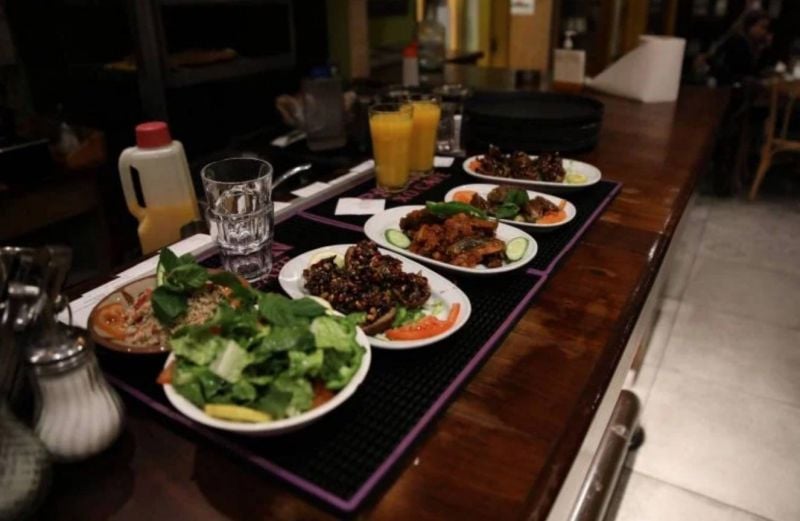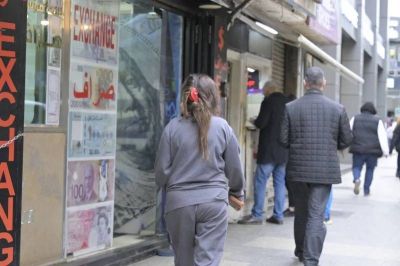
According to current estimates, prices in restaurants are on average between 20 and 30 percent cheaper than in 2019. (Credit: Florient Zwein/Hans Lucas)
“Prices in restaurants are higher than in 2019.”
“But no, this is misleading, I can’t even book a table.”
“And they say [the cost of living in] Lebanon is not expensive…”
“I don’t understand how restaurants are packed.”
These are just a few of the now common expressions said by Lebanon's residents and visitors of late. It seems that based on the consumer price index, measured by the Central Administration of Statistics (CAS), prices in Lebanese lira in restaurants and hotels were multiplied by 225 between April 2019 and April 2023, while the lira exchange rate to the US dollar has only multiplied by 65 times.
In simpler terms, this indicates that prices in dollars rose by more than three times in a span of four years. But how is this possible in a crisis-stricken country?
L’Orient-Le Jour asked three experts this question:
Tony Ramy, the head of the Syndicate of Owners of Restaurants, Cafes, Nightclubs and Patisseries
Prices charged in cafés and restaurants today range between 65 and 75 percent of their pre-crisis value in 2019. Prices in bars and nightclubs are the same as in 2019, despite higher operating costs and increased utility expenses — gas, electricity, water and water treatment.
These expenses have thus risen from eight percent — which is normal — to 25 or even 30 percent in low season, which is obviously unsustainable.
At the same time, the cost of goods sold has also increased, given the global inflation and rising energy and transport costs, which have, for instance, pushed up prices by 50 or even 100 percent in restaurants in foreign countries.
In addition, the exchange rate used to calculate customs duties on imported goods increased, while Lebanon continues to be a largely importing country. While this ratio ranged between 25 and 30 percent in the past, it is now between 35 and 37 percent [of the cost of goods sold]
Restaurants set prices based on this data, and take into account the restaurant’s location, brand image, food quality and the fact that Lebanon has a free market regime. Then, market equilibrium is achieved through competition and service quality.
It’s not in the interest of any institution to raise its prices more than it should, or in a way that exceeds the acceptable profit margin, otherwise customers will be driven away.
We have seasonal tourism, and restaurants rely on their regular customers for the rest of the year. Setting fair prices is the best way to gain their loyalty and achieve long-term sustainability.
At the end of the day, it’s the customers who decide on whether or not to go back to this or that institution, and who share their reviews on the restaurant with their friends and family and on social media.
That’s why prices need to be clearly displayed, whether on the menus, at the restaurants’ entrances or on social media, so that customers can decide which restaurant to go to.
I can tell you, as syndicate head, that what matters is to offer plenty of choices for all budgets.
Nagi Morkos, managing partner at Hodema consulting services
This is not true. Although prices increased over the past year, they are not higher than they were before the crisis. According to a price index we calculate, dollar prices charged in restaurants are between 20 to 30 percent lower than they were in 2019. This is despite global inflation and soaring energy prices.
It’s the cost of goods sold that is mounting, but prices were not revised upwards. As a result, profit margins plummeted for restaurateurs, who have been striving for survival for several years now. While some restaurants are operating at full capacity, others have been forced to close down due to the economic crisis.
While the average pre-crisis price of a croissant in cafés was $3.5, it is now between $2 and $2.5; while the average price of a burger ranged between $10 to $12, it now costs between $9 and $11. Similarly, alcohol prices are below pre-crisis levels.
The Lebanese feel that prices soured for two reasons. Firstly is that the purchasing power of many Lebanese dropped, and they can no longer afford the same habits.
Secondly is that prices used to be displayed in Lebanese lira and were constantly being revised upwards, while the lira was depreciating. But now that prices are denominated in dollars, it has become easier for customers to compare and pay much more attention to price variations, which restaurateurs are well aware of.
As for a possible price increase in restaurants as the summer season approaches, I don’t think it will happen, at least not in the majority of establishments. It would be counterproductive in the long term and would not encourage regulars to return.
Rudy Abdallah, chef and food consultant
It is an illusion to perceive that prices in restaurants today are higher than before the crisis. This is due to the lira collapse against the dollar, and subsequent drop in the purchasing power of a large segment of the population, and fall in the real value of their salaries.
For instance, a chef who earned $2,000 a month in 2019 now earns an average of $1,000. It should be noted that there is also a significant proportion of workers whose salaries are still paid in Lebanese lira and are calculated at a much lower rate than that in force on the market. This sometimes results in very low monthly salaries, below $100.
But for people whose income has not been affected over the past four years, eating out costs less today than it was in 2019. If you compare prices in restaurants, you’ll find that they’re in most cases cheaper than they were in 2019, with some restaurants displaying prices that can sometimes be up to 40 percent lower than pre-crisis levels.
However, some restaurants have indexed their prices to the dollar at the outset of the crisis, and their rates are almost equivalent to those of 2019.
At the same time, the other factor that explains this impression is that the majority of restaurants were slow to adjust their prices in line with the lira depreciation, before gradually increasing them.
This was seen in several sectors. As a result, while $100 might have been enough to cover a week’s or ten days’ worth of expenses in 2021, the same sum now only covers the expenses of three to four days.
If we look at things from this angle, then yes, prices have risen. With the same sum of money and in the same restaurant, we could afford more dishes two years ago. However, despite these increases, today’s prices are still lower than in 2019.
This article was originally published in French in L'Orient-Le Jour. Translation by Joelle El Khoury.

